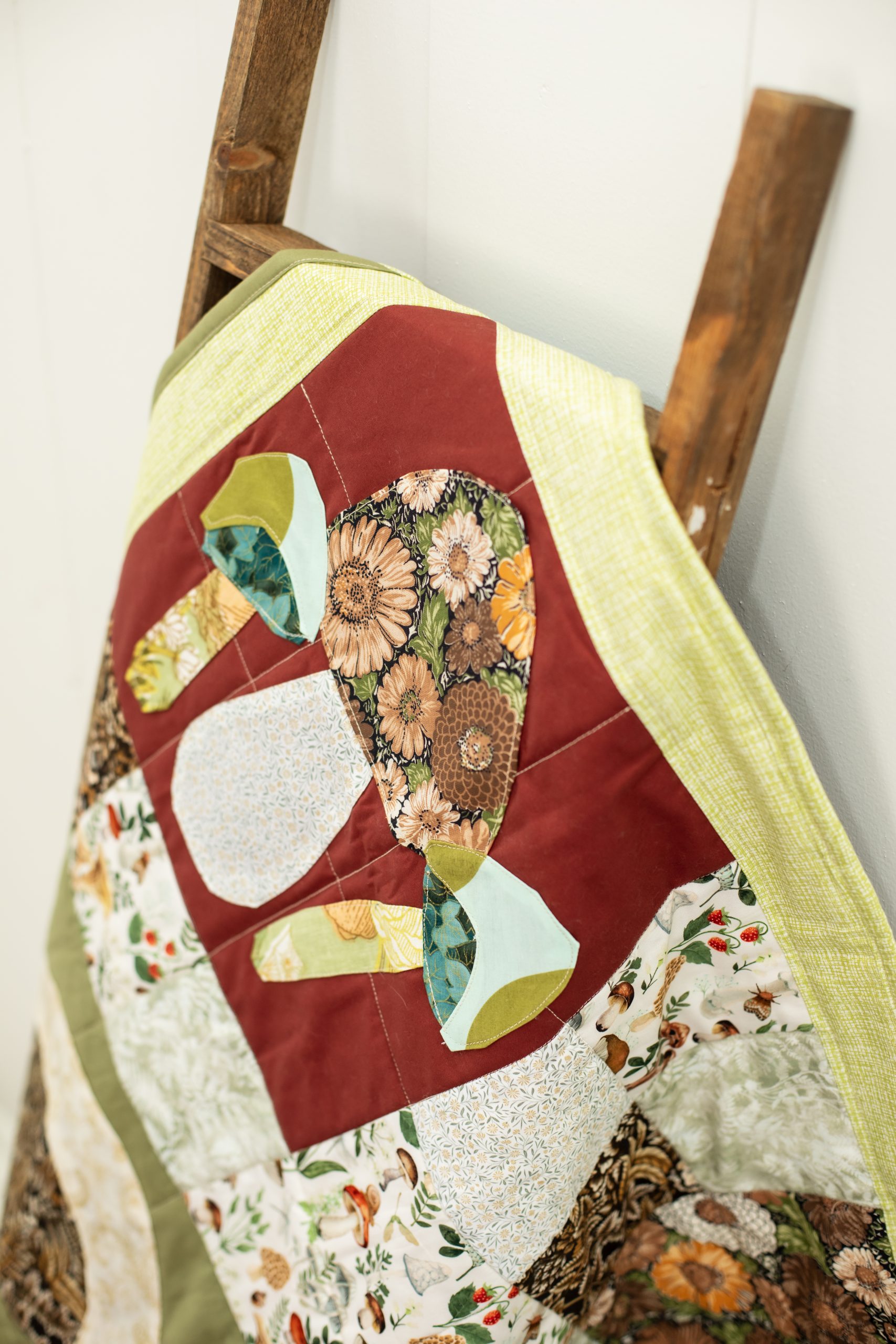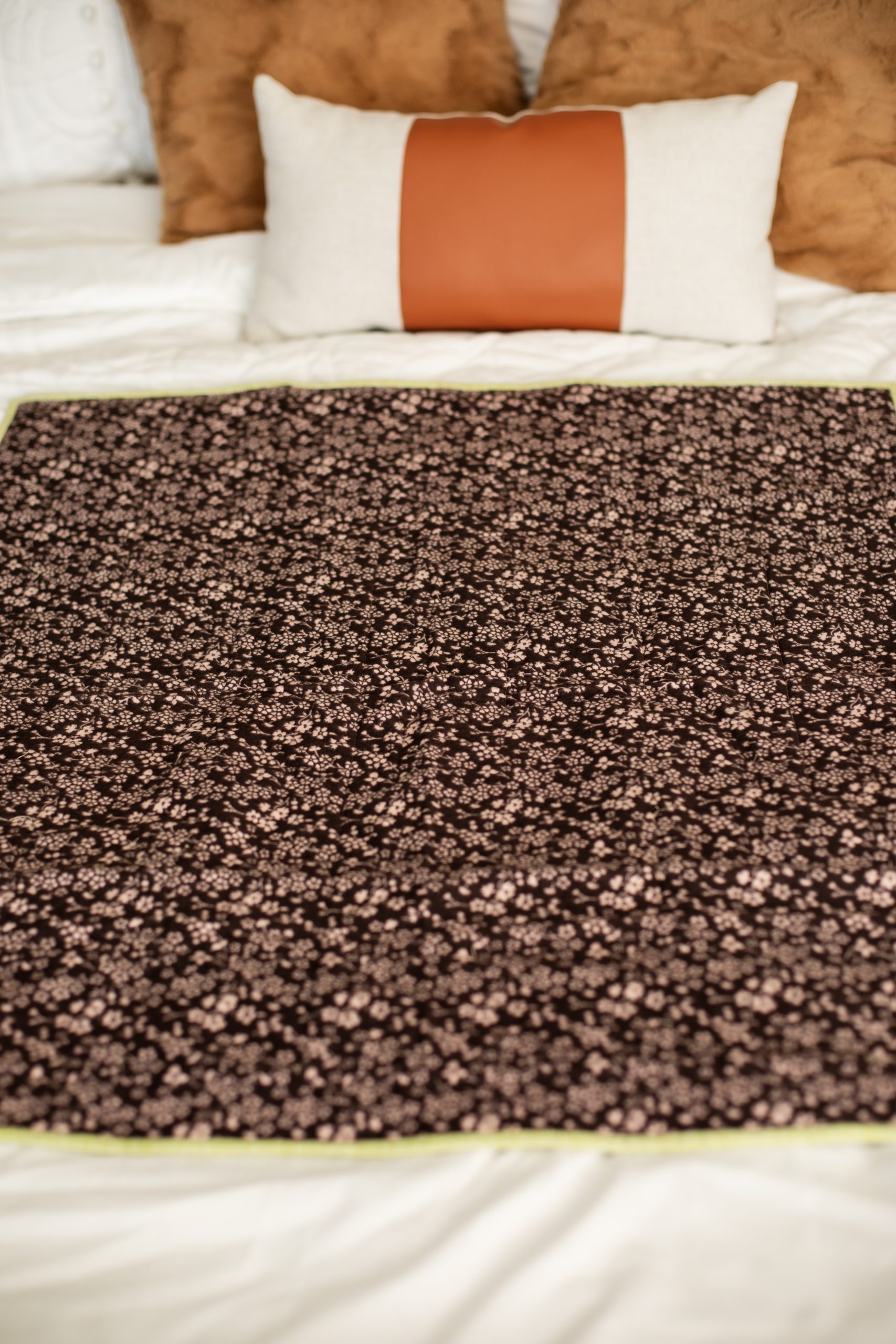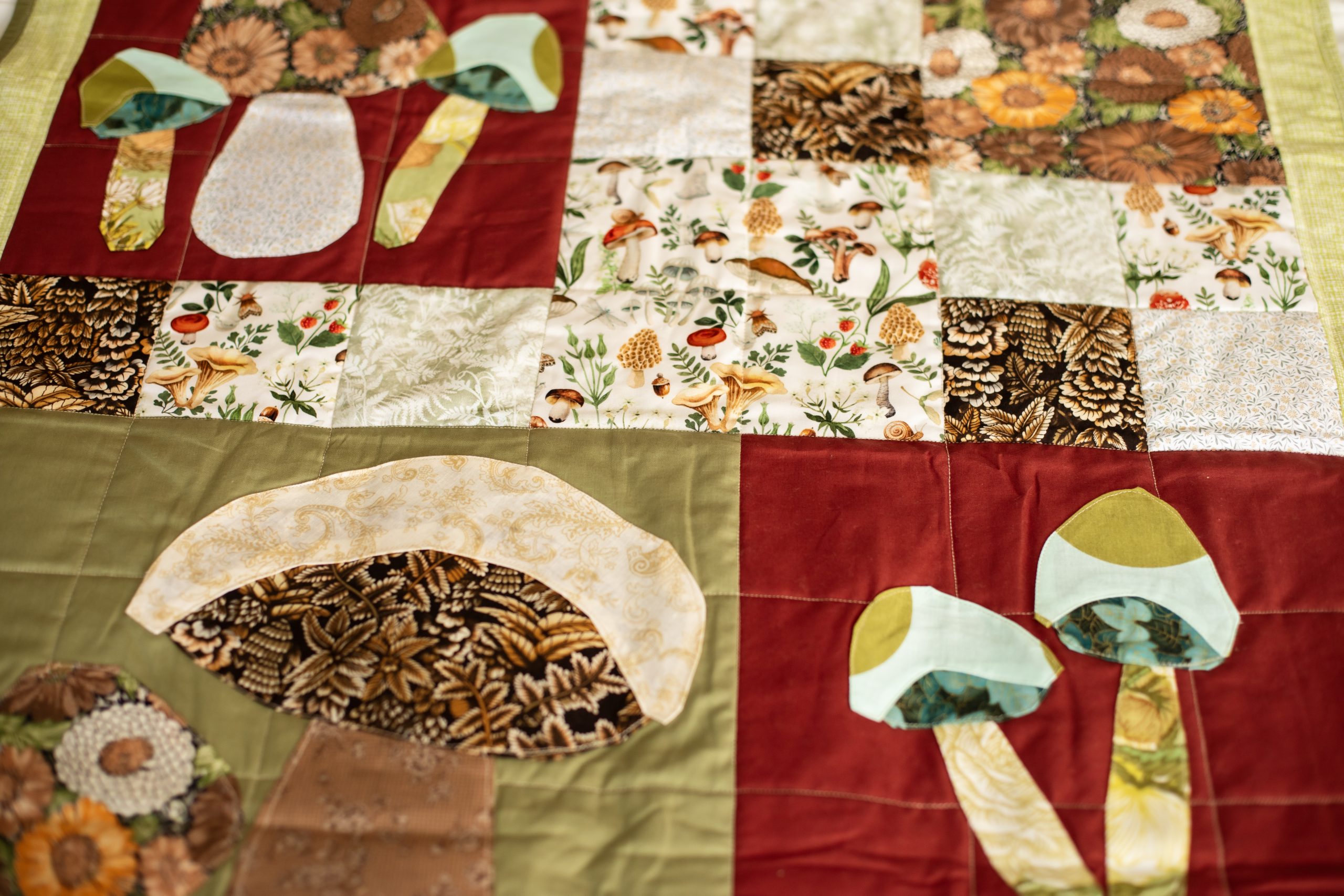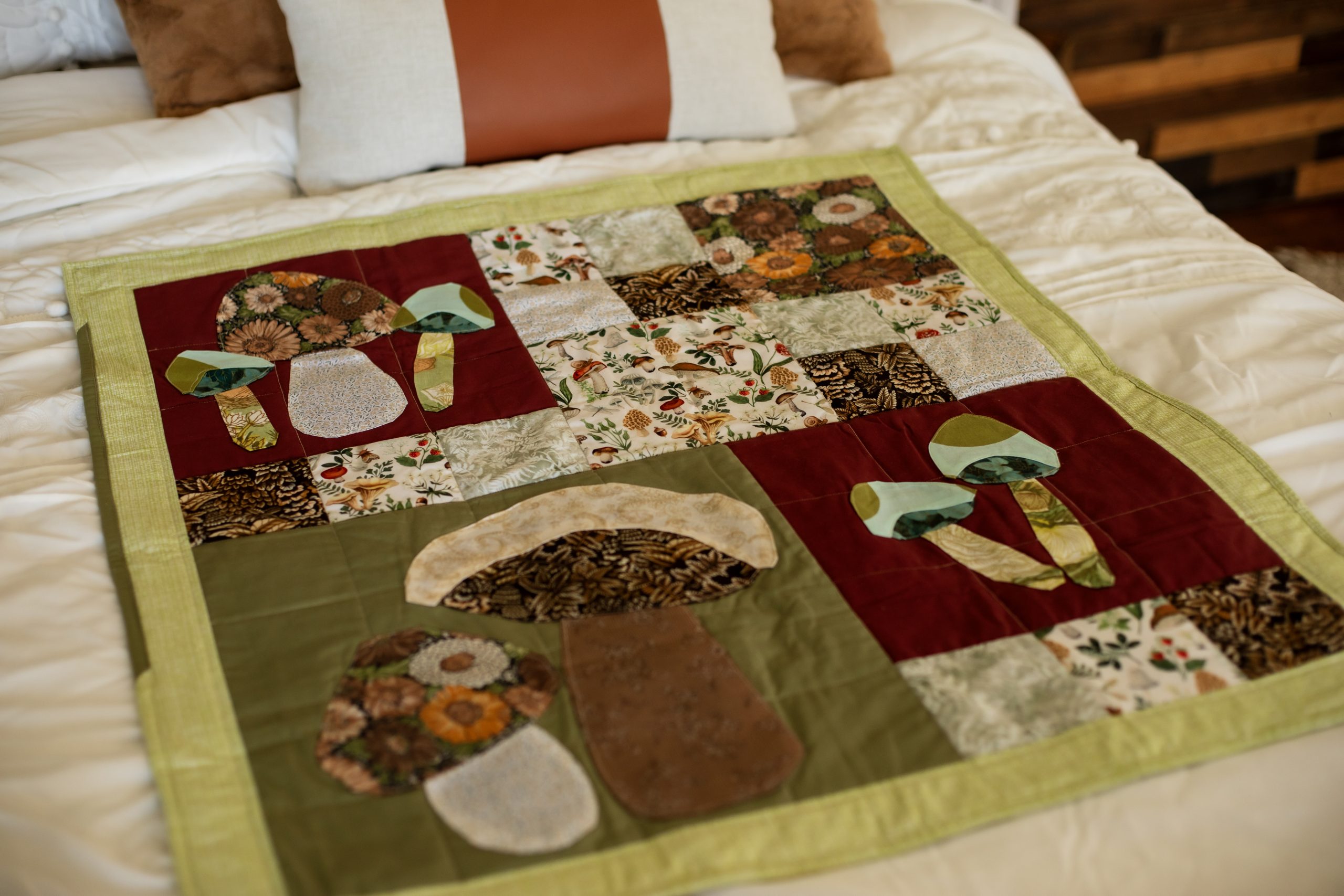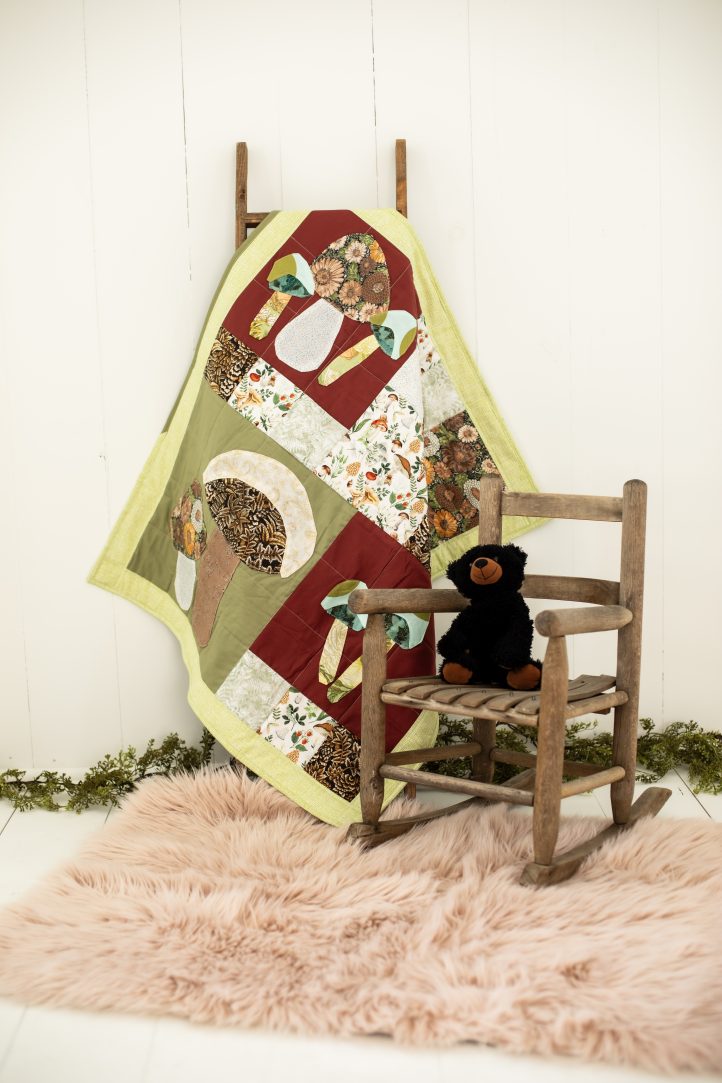
Give your newest addition a groovy welcome with this delightful 70s-inspired baby quilt pattern from Janice Bailor. Finishing at 32 1/2 inches by 36 1/2 inches, this retro baby quilt pattern is made in soothing shades like sage and suede brown and features whimsical mushroom designs in varying sizes. This baby quilt is a fantastic project for showcasing Mid-Century inspired prints, such as the floral and mushroom prints used in our sample, and is a lovely gender-neutral option for nursery décor. Gift the mom-to-be in your life with this adorable baby quilt at an upcoming shower or celebration.
Skill Level: Easy
Finished Dimensions: 32 1/2 inches wide by 36 1/2 inches long, baby/crib quilt
Seam Allowances: 1/4 inch for all patchwork
Designer Note: “RST” means Right Sides of fabric together
Materials:
- 2- Fat quarters solid fabric (Kona Cotton colors shown: 1082 Cocoa and 165 Ivy)
- 2- 1/4 yard or fat quarter 1970s inspired mushroom and floral prints (Prints shown: brown vintage floral, Northcott “Wild Harvest”)
- 3- 1/8 yard or fat eight basic blender fabrics or secondary small prints (Prints shown: Northcott “Stonehenge”, Paint Brush Studio “Micro Daisy” and Hoffman Fabrics “Brown Fern”)
- 1- 1 yard coordinating cotton or flannel fabric backing
- 1- 1/2 yard cotton for borders and binding (Fabric shown: Benartex “Lime Green Color Wave”)
- 1- Cut batting 36 inches by 45 inches or one crib-sized batting package
- PDF Templates – These are located at the bottom of this page. See printing instructions below.
Tools:
- Walking foot
- Rotary cutter, mat and acrylic ruler
- Heat n’ Bond Iron-on Adhesive, iron and ironing board
PRINTING INSTRUCTIONS:
To download the PDF templates, click on the download button at the bottom of the page. We recommend opening your download using Adobe Acrobat.
Cutting Instructions:
- Line up selvages and press all fabrics to remove any creasing or wrinkles.
- Neaten and trim up the cut edges along the WOF (Width of Fabric) with a rotary cutter, ruler, and cutting mat as required to create an even edge.
- From the newly trimmed edge, use the cutting mat grid and acrylic ruler to cut:
- 1- 16 1/2 inch square of Kona 165 Ivy
- 2- 12 1/2 inch squares of Kona 1082 Cocoa
- 1- 8 1/2 inch square, and
- 4- 4 1/2 inch squares of “Wild Harvest” Mushrooms
- 1- 8 1/2 inch square of brown vintage floral
- 4- 4 1/2 inch squares light secondary print (“Stonehenge”)
- 4- 4 1/2 inch squares dark secondary print (“Brown Fern”)
- 2- 4 1/2 inch squares light secondary print (“Micro Daisy”)
- 4- 2 1/2 by 32 1/2 inch, and
- 4- 2 1/2 inch by WOF of Benartex Lime Green
Piecing Instructions:
CREATING THE MUSHROOM APPLIQUE PANELS:
- Use the PDF templates to create the mushroom appliqué panels. Pin the templates to the desired fabrics and use the templates to cut out all shapes as follows:
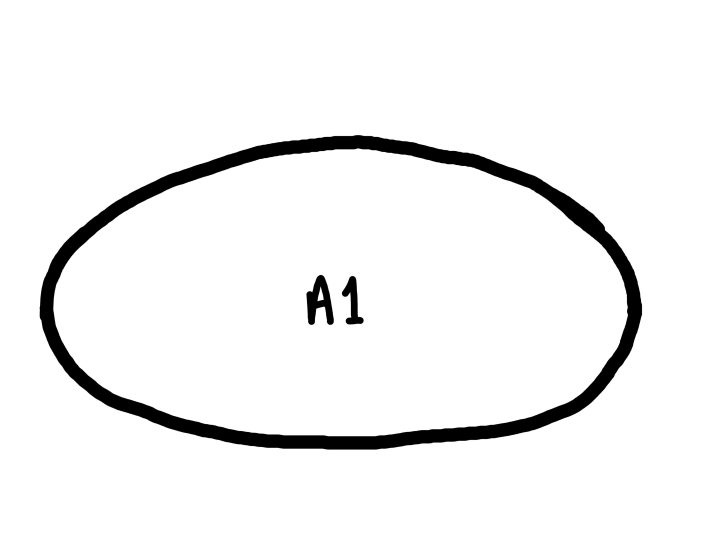
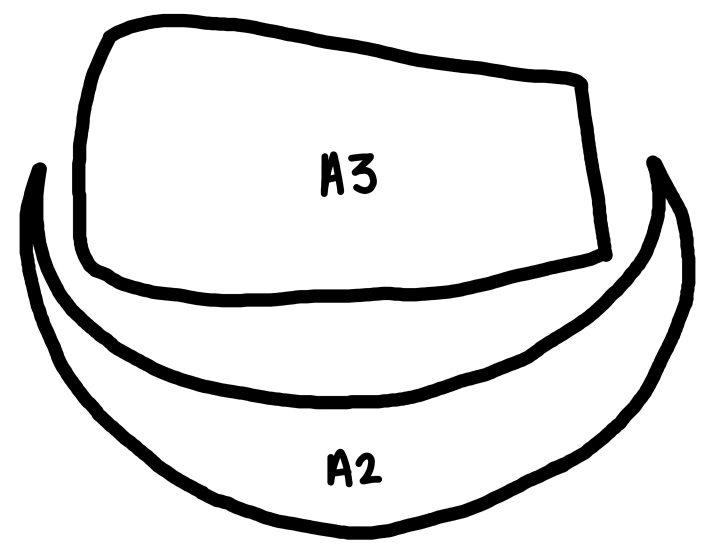
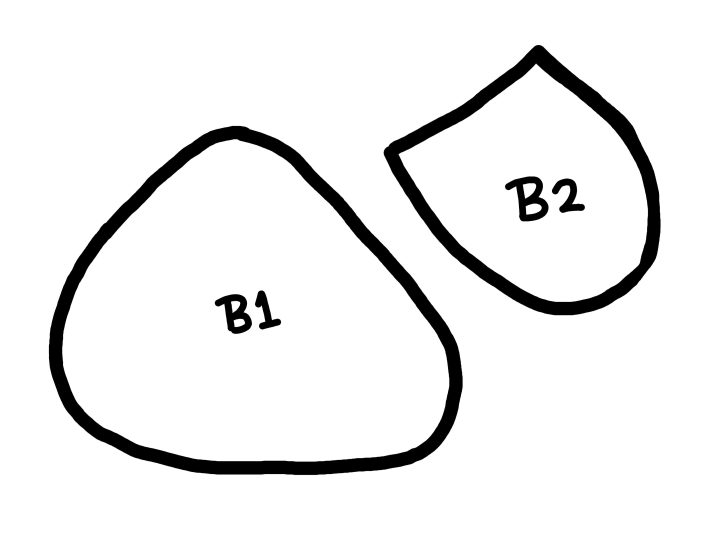
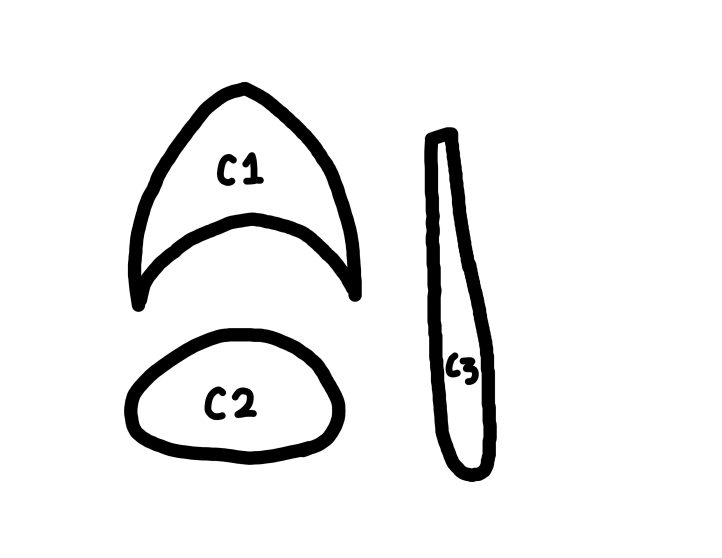
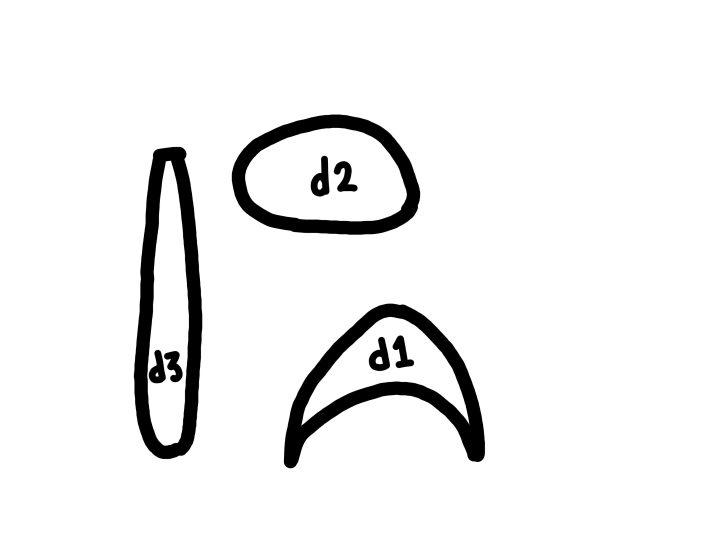
- Make 1 mushroom templates A1, A2, A3.
- Make 2 mushroom templates B1 and B2.
- Make 2 each mushroom templates C1, C2, C3 and D1, D2, D3.
- Begin by adhering Heat ‘n Bond to the back of all mushroom template layers following the manufacturer’s instructions.
- Peel the Heat ‘n Bond backing from the printed templates and use a hot iron to fold over and press all of the edges 1/4 inch if desired.
- Arrange the mushroom templates according to the Layout View, making sure to leave a 1/2 inch seam allowance between all appliqué pieces and the edges of the quilt block panel.
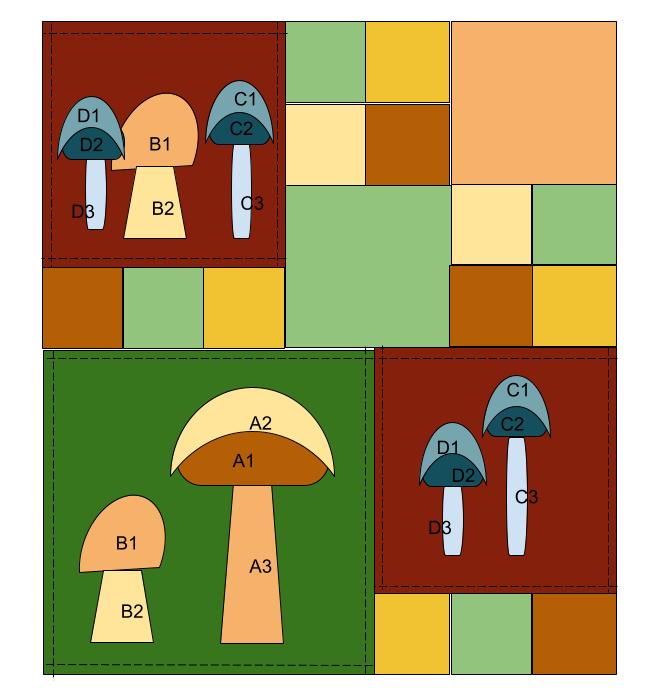
- Use a hot iron to adhere to the background panels following the Heat ‘n Bond instructions to create (2) 12 1/2 inch square Cocoa Mushroom Appliqué Panels and (1) 16 1/2 inch square Ivy Mushroom Appliqué Panel.
- After all appliqué elements are in place, top sew using straight or decorative stitches as desired around all of the appliqué perimeters to secure. Set aside.
MAKING THE 4-PATCH BLOCKS AND ROWS:
- Using the 4 1/2 inch squares, arrange your fabrics in groups of four, contrasting colors or prints in opposite corners is recommended. For arrangement suggestions, refer to Layout View above.
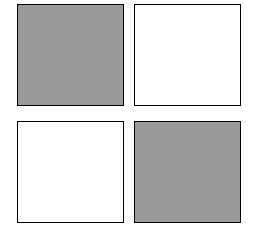
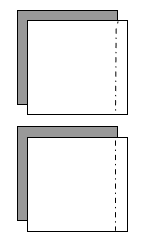
- Place the right sides (patterned sides) of the fabrics together for each row, lining up the raw edges of the squares. Sew squares together using a 1/4 inch seam along the right edge for both pairs.
- Open each sewn pair and press the sewn seams toward the dark sides with a hot iron.
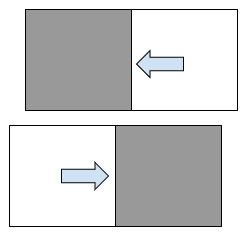
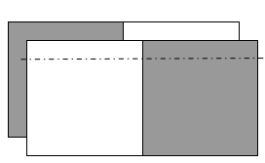
- Use the little ridge created by the seams to line up the center point of the squares of both rows and pin in place. Sew unit right sides together using a 1/4 inch seam.
- Refer to Layout View and repeat Steps 1-4 to create a 4-Patch unit from the pieced 4 1/2 inch square units and the 8 1/2 inch print blocks. Set aside.
- Refer to Layout View and create two 3-block strips of pieced 4 1/2 inch blocks using the piecing method as outlined in Steps 1-3 above.
- Place the 3-block pieced strips RST on the bottom of the 12 1/2 inch Cocoa Mushroom Appliqué panel and use a 1/4 inch seam to attach. Open and press.
- Repeat for the remaining 12 1/2 inch Cocoa Mushroom Appliqué panel and 3-block strip pieces.
MAKING THE PIECED QUILT TOP AND BORDER:
- Use the Layout View and create the top patchwork panel by placing the RST of one 12 1/2 inch Cocoa Mushroom Appliqué panel and pieced blocks unit with the 4-patch pieced unit, and use a 1/4 inch seam to join them together into the top panel.
- Place the remaining 12 1/2 inch Cocoa Mushroom Appliqué panel and pieced blocks unit RST with the 16 1/2 inch Ivy Mushroom Appliqué panel and sew together using a 1/4 inch seam to create the bottom panel unit.
- Open both pieced panel units and press all seams flat.
- Lay the top panel unit and bottom panel units RST and sew 1/4 inch seam to join into the pieced quilt top.
- Place a 2 1/2 by 32 1/2 inch Lime Green border strip RST on the left and right long sides of the pieced panel quilt top and pin in place.
- Attach the strips using a 1/4 inch seam allowance down both sides. Open and press flat.
- Add the remaining 2 1/2 inch by 32 1/2 inch Lime Green border strips across the top and bottom of the panel from end to end, overlapping the side border edges. Open and press flat to complete the pieced quilt top.
QUILTING AND FINISHING:
- Cut a strip of batting and backing approximately 2-3” wider and longer on all sides than your finished quilt top.
- Assemble the quilt sandwich for the quilt by laying out the backing (right side down), batting in the center and quilt on top, right side up. Baste and quilt as desired and trim edges. The cover quilt has been quilted in a straight line pattern following the seam lines of the piecing.
- Prepare the binding by cutting 2 1/2” by WOF strips of fabric and attaching all strips together on the diagonal. Press strips wrong sides together in half lengthwise along the entire length of the binding to complete.
- Attach binding to the quilt sandwich by lining up all raw edges, and mitering the corners as you go.
- To miter corners, sew into the corner, stopping 1/4″ in from the end, backstitch, and remove the quilt from the sewing machine.
- With the quilt laying flat, fold the binding up and away from the quilt, making the binding straight with the unsewn side.

- Fold the binding down to the sewn side, leaving a diagonal fold on the underside of the binding and pin fold in place.
- Place the quilt back into the sewing machine and sew down the fold and continue on sewing binding.
- Make a miter at each corner, adjusting the amount of fold as necessary.
- Join the ends of the binding together where they meet and attach to the quilt sandwich.
- Press and fold the binding over to the opposite side of the quilt to finish. Tuck the mitered corner flat, pinning it into place as necessary.
- Finish the binding with your preferred method, either by hand stitching in place or by machine stitching.

